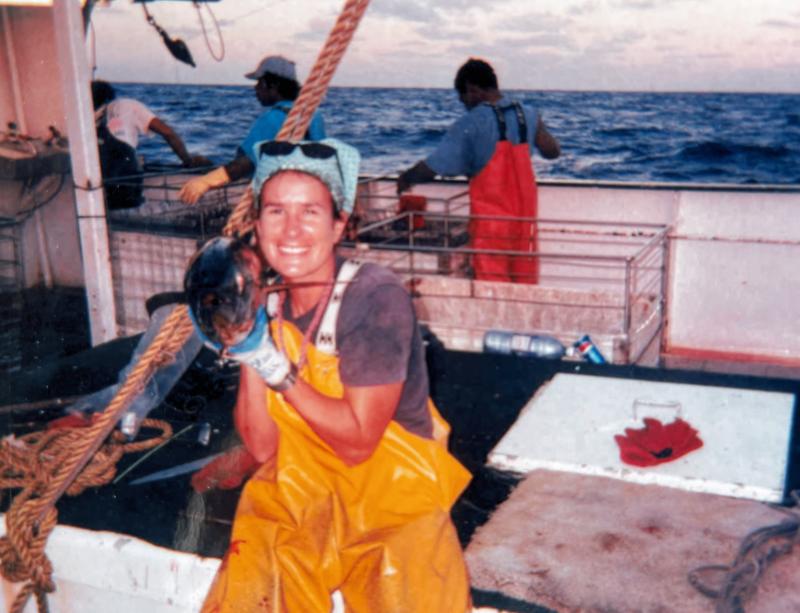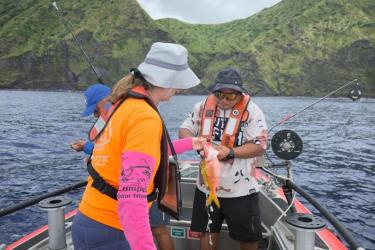What do you do at NOAA Fisheries?
I am a supervisory fish and wildlife administrator in the Sustainable Fisheries Division at the NOAA Fisheries Pacific Islands Regional Office.
Tell us a little bit about yourself!
I grew up as a child “military brat” of a parent serving full-time in the U.S. Army. My first memories as a child began in Hawai‘i—followed by Alabama, Tennessee, and Virginia. My family was very active, and my two brothers and I were always involved in sports. I still enjoy being active today and share my love of the outdoors with my husband, 5-year-old son, and two chocolate Labradors. When we are not working or at preschool, you can find us surfing, snorkeling, stand-up paddleboarding, hiking, riding bikes, scooters, and skateboards, and painting rocks. Occasionally, we eat and sleep!
What are a few words that describe you?
Determined, driven, honest, curious, and fun-loving.
What got you into fisheries?
My curiosity, love for the ocean, and desire for adventure. As a 20-something fisheries technician at the Virginia Institute of Marine Science (VIMS), I worked on several fishery research surveys, including the winter blue crab dredge survey. These surveys were generally day trips, but on occasion we would moor overnight in a protected bay or at Tangier Island. More often than not, we would get wet, cold, and muddy—I absolutely loved it!
During the summer, I worked on a gill and cast net survey for environmental monitoring in the rivers and tributaries of the Chesapeake Bay. These day trips sometimes involved sites that were hours away, requiring us to stay overnight at the VIMS campus on the Delmarva peninsula. From these experiences, I learned not only how to trailer a 17-foot skiff (thanks to my patient, small team), but also how to drive a boat, lay and mend gill nets, and throw a cast net. Besides the occasional painful poke from a catfish and pinch from a crab, I found this work to be extremely satisfying. It was challenging at times, often adventurous, and always enjoyable, especially when we stopped for ice cream on our way home.
When did you know that this is what you wanted to do?
My field work as a technician at VIMS got me into the field. When I returned to Hawaiʻi as a fishery scientific observer in the Hawaiʻi-based pelagic longline fishery, I knew this was the kind of work I really wanted to engage in fully. I am passionate about sustainable fisheries and natural resource management.
Being the only woman on a commercial fishing vessel hundreds of miles at sea was initially intimidating. In fact, after completing observer training, I asked for my name to be moved to the bottom of the list of available observers. I had jitters and began to question what in the world I had gotten myself into. How would I establish myself among the crew and captain, people I did not know? And most importantly, where would I go to the bathroom (most boats do not have a working head!)? After a bit of soul searching, I convinced myself this was an amazing opportunity, and I was determined to stretch outside of my comfort zone. I would have to trust that everything would be fine, and that I would indeed be able to find the “toilet.”
I spent more than 3 years as an observer—each boat was a different adventure, some good and some not-so-good. I enjoyed really fresh sashimi, and I tried to enjoy eating swordfish heads …with some reservation. I learned about different cultures and languages, such as Vietnamese and Tagalog (a Filipino dialect). I realized how hard the captain and crew work, with very little sleep, and how in tune they are with the ocean. I understood the value of the data I was collecting, and how it was being used to manage the fisheries and protect species listed under the Endangered Species Act (ESA) and the Marine Mammal Protection Act (MMPA). I took pride in being an observer, knowing that I was contributing to science and fishery management. I knew then that this was the kind of work I wanted to continue doing.
Why is your work important?
I am thrilled to be working in the Pacific Islands Regional Observer Program again, though in a different capacity. This time I am a co-manager who oversees the contract for observer services and the collection of observer data. I also manage how the data are shared with our science and regulatory partners. Observer data is an independent data collection process that captures operational data, such as the catch composition of target and non-target species, protected species interactions, and gear configuration. This data contributes to science, fishery management, and the conservation of ESA-listed species.
What advice would you have for youth interested in working at NOAA Fisheries?
Become a fishery scientific observer! Yes, I am a bit biased and am always looking for bright folks who work well independently. Granted, it is not for everyone, but it is an opportunity to learn about the pelagic fishery of Hawaiʻi and how NOAA plays a role in sustainable fisheries management.
If observing is not your jam, I would recommend finding out what part of NOAA’s mission excites you most. Our office has an amazing communications team that regularly hosts outreach events. Attend these events to discover more about NOAA, network, and learn about volunteer opportunities.





